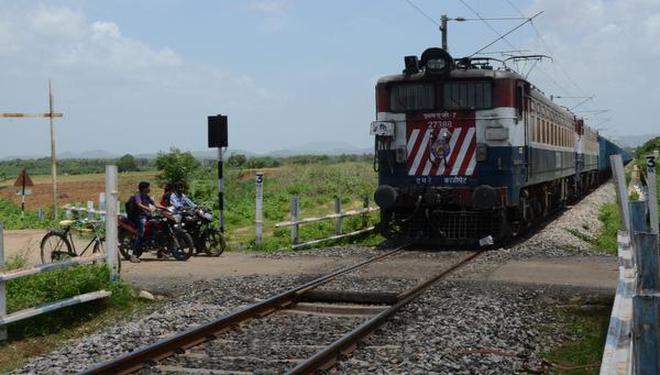http://www.thehindu.com/opinion/lead/where-the-law-needs-to-change-track/article23805541.ece

Where the law needs to change track: on the Railways Act
The recent deaths of schoolchildren at an unmanned rail crossing highlight why the Railways Act must be amended
In late April, a bus with schoolchildren collided with a train at an unmanned railway level crossing, near Kushinagar in Uttar Pradesh. Thirteen of them died. This is not the first time that an incident of this nature has occurred, so some questions need to be asked. Is there any mandate for manning all level crossings? In an incident such as this, where the bus driver was reportedly negligent, is the railway administration liable even if the train engine driver cannot be faulted?
Legal issues
We can look for some answers in a 1997 Supreme Court judgment (Union of India v. United India Insurance). In May 1979, at Akaparampa in Kerala, 40 passengers and the driver of a passenger bus that had been hired were killed when the vehicle was hit by a train at an unmanned level crossing. Cases were filed before the Motor Accidents Claims Tribunal, Ernakulam, claiming compensation against the owner and insurance company of the bus as well as the Indian Railways. The Tribunal awarded compensation against the owner. The liability of the insurance company was restricted to a measly ₹500 per victim on the basis of restriction of liability contained in the terms of the policy. In appeals taken to the High Court, the Railways too was made liable for negligence in not making provisions for a gate and personnel to mind the gate. Aggrieved, the Railways went to the Supreme Court. The legal issues addressed by the Supreme Court are instructive for what the Railways was required to do.
A claim for damages for negligence of the defendant falls in the arena of a civil wrong called a tort action. In relation to claims for railway accidents, the Railways Act provides for fixed compensation on predetermined scales. It also provides a forum for passengers to make claims in the form of Railway Claims Tribunals situated in different parts of India. But there is a limitation. Only a passenger on a train can make a claim before the Tribunal. Passengers of a bus or motor vehicle who may have been harmed after a collision with a train can only approach the Motor Accidents Claims Tribunal. However, this tribunal can entertain the claim against the Railways also as a joint tortfeasor if the negligence of the Railways is established.
In the course of the judgment, the Supreme Court borrowed the neighbourhood principle articulated in Donoghue v. Stevenson (1932). It said that the duty of care for the Railways extends not only to those who use the Railways’ services but also to people who are “neighbours” — namely, users of vehicles on roads that intersect with tracks. Consequently, there is a common law liability for the railway administration for an accident at an unmanned crossing, even in the absence of specific provisions in the Railways Act, where the Central government can direct the administration to lay manned crossings. An action at common law can be filed for nonfeasance because the Railways was involved in what are recognised as dangerous operations and hence is bound to take care of road users.
It took up the issue of whether there could be any breach or a common law duty on the part of the Railways if it does not take notice of the increase in the volume of rail and motor traffic at the unmanned crossing, and if it does not take adequate steps such as putting up gates with a watchman to prevent accidents at such a point. It said that there existed a precedent from England that was examined by the House of Lords — that the Railways should take all precautions that will reduce danger to the minimum. It approved the estimate made in Lloyds Bank Ltd. v. Railway Executive (1952) that if 75 to 100 vehicles crossed the level crossing per day, the Railways owed a duty of care at common law to provide for a gate with a watchman. If such a duty can be seen from factual circumstance, the corollary shall be that non-exercise of the power of the government to direct the Railways to lay gates shall be construed as irrational. Alternatively, if the plaintiff had no idea of particularly relying upon the exercise of power by the authority in his favour but is a matter of general reliance, society could by previous experience expect the exercise of such a power and if such an expectation stood belied, then too a conclusion could be drawn that the non-exercise of power by the authority was irrational. The running of trains by the Railways, as pointed out in Commissioner for Railways v. Mc Dermott (1966), has been recognised as inherently perilous and creates a general expectation that safety measures have been taken by the railway administration.
Need for continuous audit
The decision by the Railways to equip all level crossings in India with gates by 2020 does not mean that unmanned gates will be relegated to history. After all, these gates have not come about because the Railways laid tracks across roads and kept these places unguarded. On the other hand, because of the operations of the Railways, where tracks are laid across large tracts of land, there is greater human movement in these areas; in turn, roads are laid across tracks on both sides. The railway administration should have continuous audit of tracks; when new roads come on either side, traffic must be calibrated, adequate infrastructure built, and safety measures put in place. The Railways Act 1989 (through Section 124) provides compensation on strict liability basis. This means that “when an accident occurs in the course of working a railway” (a collision between trains, or when one is a train carrying passengers, or derailment, or any other accident with a train or any part of a train carrying passengers), then whether or not there has been any wrongful act, neglect or default on the part of the railway administration, an injured passenger or one who has suffered a loss can lawfully maintain an action and recover damages.
Have an amended law
On instructions from the principal Bench in Delhi, in every one of the major accidents in India between 2016 and 2017, the families of victims were contacted by the Tribunals where the families resided, and applications for compensation filed. There was quick adjudication for payments. In the incident of a stampede on a foot overbridge at Elphinstone Road station, in Mumbai in 2017, the Bombay Bench of the Railway Claims Tribunal awarded compensation amounts without any contest from the Railways. Hitherto, responses to claims for compensation arising out of accidents have been on an ad hoc basis but it is time the government amends the Railways Act to provide for compensation on a proactive basis without driving victims or their families to file applications in Tribunals. The ex gratia payments will then be substituted by rights-based compensation regimes that will sensitise the Railways to administer their operations with greater focus on public safety. It is also essential to include within Section 124 of the Railways Act a provision for a claim from a “neighbour to a passenger” in the manner that the Supreme Court recognises, namely, a road user of a motor vehicle.

